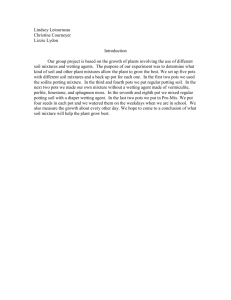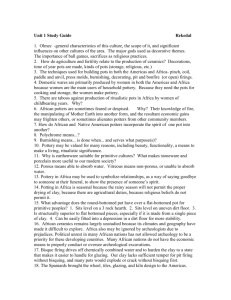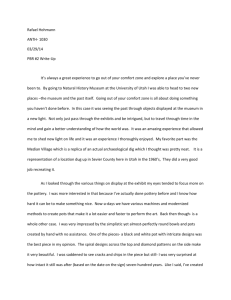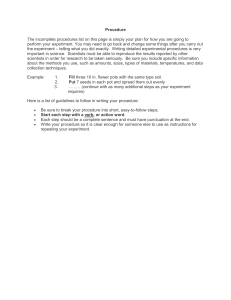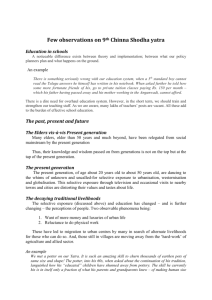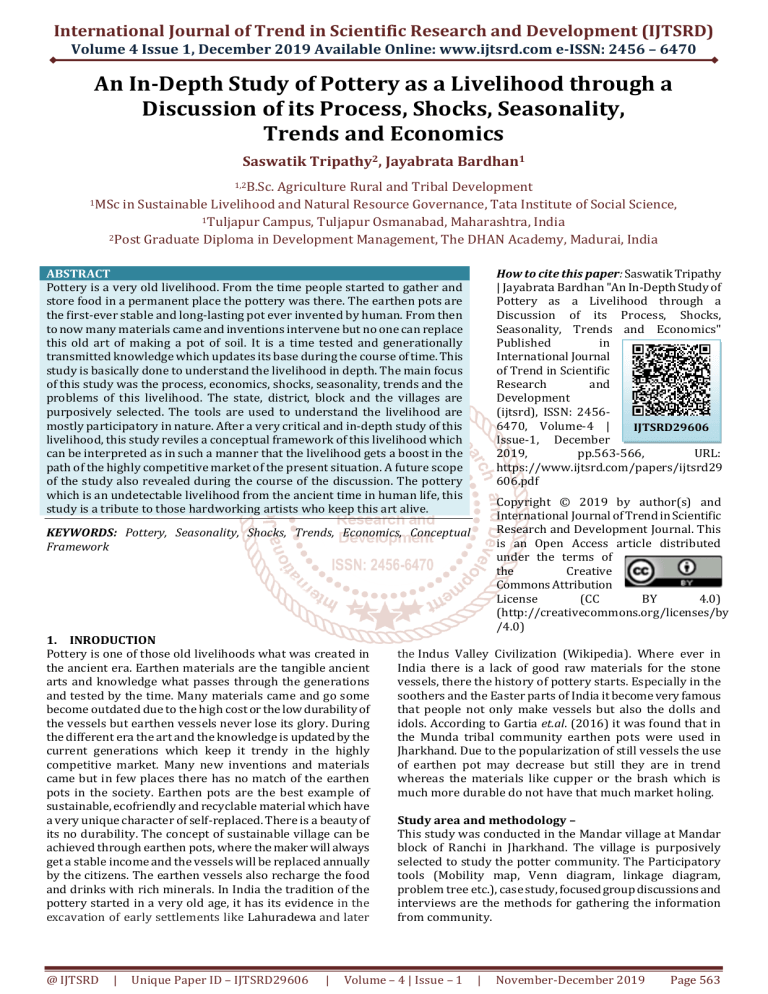
International Journal of Trend in Scientific Research and Development (IJTSRD)
Volume 4 Issue 1, December 2019 Available Online: www.ijtsrd.com e-ISSN: 2456 – 6470
An In-Depth Study of Pottery as a Livelihood through a
Discussion of its Process, Shocks, Seasonality,
Trends and Economics
Saswatik Tripathy2, Jayabrata Bardhan1
1,2B.Sc.
Agriculture Rural and Tribal Development
in Sustainable Livelihood and Natural Resource Governance, Tata Institute of Social Science,
1Tuljapur Campus, Tuljapur Osmanabad, Maharashtra, India
2Post Graduate Diploma in Development Management, The DHAN Academy, Madurai, India
1MSc
ABSTRACT
Pottery is a very old livelihood. From the time people started to gather and
store food in a permanent place the pottery was there. The earthen pots are
the first-ever stable and long-lasting pot ever invented by human. From then
to now many materials came and inventions intervene but no one can replace
this old art of making a pot of soil. It is a time tested and generationally
transmitted knowledge which updates its base during the course of time. This
study is basically done to understand the livelihood in depth. The main focus
of this study was the process, economics, shocks, seasonality, trends and the
problems of this livelihood. The state, district, block and the villages are
purposively selected. The tools are used to understand the livelihood are
mostly participatory in nature. After a very critical and in-depth study of this
livelihood, this study reviles a conceptual framework of this livelihood which
can be interpreted as in such a manner that the livelihood gets a boost in the
path of the highly competitive market of the present situation. A future scope
of the study also revealed during the course of the discussion. The pottery
which is an undetectable livelihood from the ancient time in human life, this
study is a tribute to those hardworking artists who keep this art alive.
How to cite this paper: Saswatik Tripathy
| Jayabrata Bardhan "An In-Depth Study of
Pottery as a Livelihood through a
Discussion of its Process, Shocks,
Seasonality, Trends and Economics"
Published
in
International Journal
of Trend in Scientific
Research
and
Development
(ijtsrd), ISSN: 24566470, Volume-4 |
IJTSRD29606
Issue-1, December
2019,
pp.563-566,
URL:
https://www.ijtsrd.com/papers/ijtsrd29
606.pdf
Copyright © 2019 by author(s) and
International Journal of Trend in Scientific
Research and Development Journal. This
is an Open Access article distributed
under the terms of
the
Creative
Commons Attribution
License
(CC
BY
4.0)
(http://creativecommons.org/licenses/by
/4.0)
KEYWORDS: Pottery, Seasonality, Shocks, Trends, Economics, Conceptual
Framework
1. INRODUCTION
Pottery is one of those old livelihoods what was created in
the ancient era. Earthen materials are the tangible ancient
arts and knowledge what passes through the generations
and tested by the time. Many materials came and go some
become outdated due to the high cost or the low durability of
the vessels but earthen vessels never lose its glory. During
the different era the art and the knowledge is updated by the
current generations which keep it trendy in the highly
competitive market. Many new inventions and materials
came but in few places there has no match of the earthen
pots in the society. Earthen pots are the best example of
sustainable, ecofriendly and recyclable material which have
a very unique character of self-replaced. There is a beauty of
its no durability. The concept of sustainable village can be
achieved through earthen pots, where the maker will always
get a stable income and the vessels will be replaced annually
by the citizens. The earthen vessels also recharge the food
and drinks with rich minerals. In India the tradition of the
pottery started in a very old age, it has its evidence in the
excavation of early settlements like Lahuradewa and later
@ IJTSRD
|
Unique Paper ID – IJTSRD29606
|
the Indus Valley Civilization (Wikipedia). Where ever in
India there is a lack of good raw materials for the stone
vessels, there the history of pottery starts. Especially in the
soothers and the Easter parts of India it become very famous
that people not only make vessels but also the dolls and
idols. According to Gartia et.al. (2016) it was found that in
the Munda tribal community earthen pots were used in
Jharkhand. Due to the popularization of still vessels the use
of earthen pot may decrease but still they are in trend
whereas the materials like cupper or the brash which is
much more durable do not have that much market holing.
Study area and methodology –
This study was conducted in the Mandar village at Mandar
block of Ranchi in Jharkhand. The village is purposively
selected to study the potter community. The Participatory
tools (Mobility map, Venn diagram, linkage diagram,
problem tree etc.), case study, focused group discussions and
interviews are the methods for gathering the information
from community.
Volume – 4 | Issue – 1
|
November-December 2019
Page 563
International Journal of Trend in Scientific Research and Development (IJTSRD) @ www.ijtsrd.com eISSN: 2456-6470
Results and discussion –
The earthen pot making is art which take a long processing
days. There are some few steps from sourcing the clay to sell
it to a wholesaler the journey of a pot is given below –
Sourcing – Pots cannot be made from any type of soil. The
potters collect the soil either from agricultural field or from
nearly waterbodies. According to the potters the clay should
contain the of mud and sand in a proportion of 5:2. Mainly
they choose loamy soil which have a tight but smooth
texture. The indigenous knowledge of the selecting soil is
taught only to the sons of a potter not to the daughters.
According to the community teaching this technique to their
daughter is creation of the chance of piracy of their ancient
knowledge. Daughters may marry in some other clan of
people in such case the monopoly of this special knowledge
will not belong to the potter community only but to the other
clan also.
Preparing the clay – This work is mainly for the women, the
big soil pulps are broken into small pieces and put into a
vessel full of water for one night. Next day morning the execs
water is drained and the soft clay it left for making the pots.
In the case the family head feels there is a deficit of sand in
the mixture he can add some sand into it and stat to mix, role
and make the mixture bubble free. In case the mixture is not
proper during the sun drying or in the oven it pots can break
into pieces.
Making of pot – After the clay is prepared the pulps of the
clay are put on a spinning wheel and with the artistic hands
of a potter it takes the structure of a pot. The wheal can be a
manual one or automatic power by electricity.
Sun drying –
After the making of the pots they are put into the sun for
drying. After the drying this pots are put into a safe place
where it will wait for baking in the oven.
Coloring of the pots –
The pots are colored with the red hematite soil. The making
of this color is also very interesting. Red hematite soil is
soaked into the lime water over night, later those soils are
sundried and preserved for future use. During the coloring of
pots those soils are powdered and mix with water.
Making the oven –
For making of one oven it need 2.5 quintal of fuel to burn.
The fuel includes dry grass and straw for lighting the oven,
little some wood and lot of Cole for heat. It takes around
30kg of wood and rest is the Cole.
Baking of the pots – First the pots are put into a circular
format one after one and the oven light up. Then the oven is
covered with clay so from around so that the heat bake the
pots very well. After that potters wait for cooling down of the
oven and collect the red vessels from it.
Marketing – During the sundry and in weekly markets of
different village they sell their products but that is also in a
very low scale. Mainly they supply the product to the
wholesalers who have a retail shop in the city.
Economics of the Livelihood –
Table1 Cost of Production of One cycle
Particulars
Amount
Cost of Soil
1 Tractor
Rent of the vehicle
1 Tractor
Cost of labour for Soil excavation
2 man day
Cost of Wood for oven
30 kg
Cost of Cole for Oven
2.5 Quintal
Rent of the land
Producer's Own family labour
14 skilled man days + 7 unskilled man days
Total
Table no 1 Shows the cost of production for a cycle of pottery
making. This is a cycle of two weeks and lots of process are
going on into this cycle as described previously. As the
potters are one of the landless tribes they have to purchase
even the soil from the farmers, it cost around Rs.1000 for
one cycle, to bring the soil to the workshop and excavation of
soil from the field also take some more Rs.1450. Which need
two man days laour to complete the job. After that the rent of
workshop and farmers own labour cost nearly Rs.6800.
Which includes 14 skilled man days and 7 unskilled man
days to complete the entire job. The fuels for the oven cost
another Rs.3300. It cost around Rs.12550 for the whole
process.
Cost in Rupees
1000
750
700
300
3000
500
6300
12550
Table2 Products and the It’s price
Cost (Rs. Per Products Cost
unit)
unit)
Pitcher
50
Bowl
Big Lamp
10
Lamp
stand
Small
5
Plate
Lamp
Rice Pot
55
Piggy
bank
Marriage
50
pot
Products
(Rs. Per
55
8
35
30
Table no 3 shows the income from the one cycle of the
production. In a cycle there are different products which are
made and sold to the wholesalers. The products and their
respective costs are given below in table no 2 –
@ IJTSRD
|
Unique Paper ID – IJTSRD29606
|
Volume – 4 | Issue – 1
|
November-December 2019
Page 564
International Journal of Trend in Scientific Research and Development (IJTSRD) @ www.ijtsrd.com eISSN: 2456-6470
Table3 Income from one cycle of Production
Products
Amount Cost (Rs. Per unit) Total
Pitcher
Big Lamp
Small Lamp
Rice Pot
Marriage pot
Bowl
30
200
400
30
40
50
50
10
5
55
50
55
1500
2000
2000
1650
2000
2750
Lamp stand
200
8
Plate
50
35
Piggy bank
30
30
Operational Loss (10%)
Total Income
1600
1750
900
1615
14535
The table three revels that there is an operational loss from
the unwanted accident and cracks in the pots. This is around
10% of the products and nearly Rs.1615 per cycle. So from a
complete cycle here is a gross income of Rs.14535. From this
we can estimate a benefit cost ration of 1.2 in this livelihood.
Shocks, Trends and seasonality – In any livelihood there
are some certain shocks and seasonality what cannot be omit
in any moment of time. In this case the unwanted cracks and
sudden break in the pots during taking it out of the oven is a
very big shock to the producers. Actually during this activity
if suddenly rain comes or the change in atmospheric
pressure can create a huge loss to the producers. A new
potter always face this problem, but an old potter have the
knowledge to protect the pots.
If the trend is discussed deeply it can be told that from the
ancient period this product is in the society, it has face many
change of trends from its beginning. Once there is only one
another product of stone vessels were there. But in the case
of cost and portability earthen pots are the people’s choice
that time. Later the metals came from copper to steel it has
face many product but never loses its glory. But after the
intervention low cost product from China a drastic fall of
market holding is observed. During the festivals once there
was no other choice other than earthen pots but now
products from China taking all the customers to them. This
drastic change in the trend is a very big issue to this
livelihood now.
Seasonality is the great factor of this livelihood, according to
the season the products changed in the producer’s
@ IJTSRD
|
Unique Paper ID – IJTSRD29606
|
workshop. During the summer and winter the high demand
of product is there. In the summer water pots and during
winter especially in the time of Diwali the demand of lamp is
so high that people started making product for this season
from two month before the seasons come. During the rain
the work process also slow down as there was no more
space for the sundry in the places. Other than that in all
season people work daily very hard to earn the livelihood.
Problems in the livelihood –
The main problem of this livelihood what are the producers
faced is the lack of proper raw material (Soil) for the pottery.
According to them the soil texture is not that much smooth
and tight like previous days. It may like the organic content
in the soil is very low that the holding capacity of each
particle is become very low. It is a assumption that due to the
high use of inorganic fertilizers is ruining the texture of soil.
The second problem is the low income price of the product
from the wholesaler. The price what they are getting
previously in the weekly markets, now the price of
wholesaler are not that good, but due to the decrease in local
demand there is no option other that the wholesaler.
Conclusion and way forward This problems are really very burning issue but everything
can be solved through a collective production. If all the
families nearby come together and produce like a single
organization it can reduce the fixed costs of the livelihood.
Reduction of this fixed cost will also decrease the marginal
cost of unit product. In such case the profit will increase of
each producer. Not only that people will get a strong voice to
bargain with the middleman and also in future can open own
retail outlet in the cities which can enhance the profit. The
viability of direct marketing is not studied in this study, so
direct suggestion of the direct marketing is not that much
feasible. Sometimes it become a myth that direct marketing
increase the profit of the producers but their the added
transportation cost, one day labour cost and the losses
during the transport is taking into account there is a doubt
that hardly a huge profit producers get. But a scope of study
is still there for the direct market linkage and community
marketing. From the above all information and public
communication a conceptual framework has been prepared
which is given next. In case the NGO and Government take
initiative to promote this livelihood and preserve this art
they can help the people as per the following framework.
One push from outside and inner dedication of the producers
can boot the industry into a different level.
Volume – 4 | Issue – 1
|
November-December 2019
Page 565
International Journal of Trend in Scientific Research and Development (IJTSRD) @ www.ijtsrd.com eISSN: 2456-6470
Acknowledgement –
This research work was financially supported by the host
institute The Dhan Academy and the authors express their
deepest sense of gratitude to the concerned authority of the
institute for financial assistance towards accomplishing the
study. The authors also grateful to the community members
who gave their valuable time during the course of study for
the better understanding of the livelihood.
References –
[1] Godbole, S.V.; Natarajan, V.; Giri, T.K.S.; Page, A.G.
(Radiochemistry Div., Bhabha Atomic Research Centre,
Mumbai (India)) (eds.); Moharil, S.V. (ed.) (Dept. of
Physics, R.T.M. Nagpur Univ., Nagpur (India));
Omanwar, S.K. (ed.) (Dept. of Physics, S.G.B. Amravati
Univ., Amravati (India)); Chougaonkar, M.P. (ed.)
(Environmental Assessment Div., Bhabha Atomic
@ IJTSRD
|
Unique Paper ID – IJTSRD29606
|
Research Centre, Mumbai (India)); Sant Gadge Baba
Amravati University, Amravati (India); Luminescence
Society of India, Mumbai (India); 325 p; Feb 2006; p.
167-169; NCLA 2006: national conference on
luminescence and its applications; Amravati (India); 79 Feb 2006; 8 refs., 3 figs
[2] Gartia, R.K. (Luminescence Dating Lab., Manipur Univ.,
Canchipur (India)); Nabadwip Singh, S. (Luminescence
Dating Lab., Manipur Univ., Canchipur (India));
Bhengra, D. (Archaeological Survey of India, Prehistory
Branch, Nagpur (India)) Proceedings of national
conference on luminescence and its applications.
[3] Pottery in the Indian subcontinent (Wikipedia) https://en.wikipedia.org/wiki/Pottery_in_the_Indian_s
ubcontinent
Volume – 4 | Issue – 1
|
November-December 2019
Page 566


